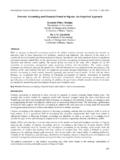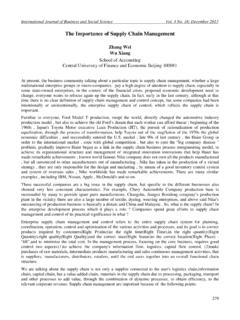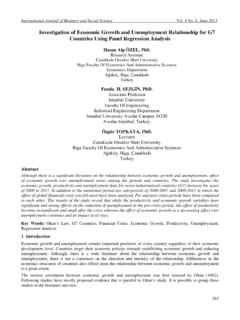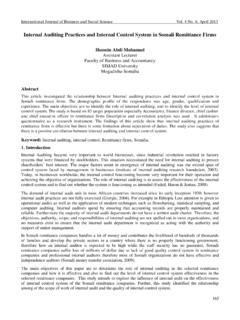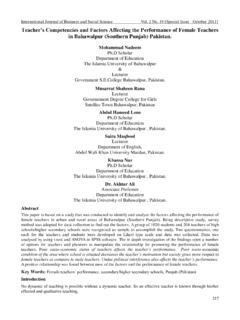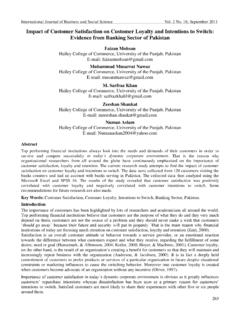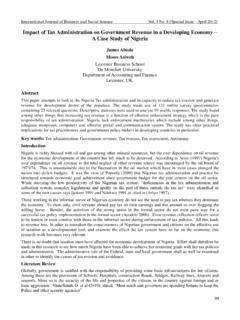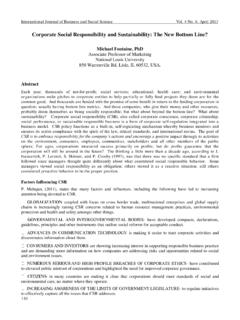Transcription of Curriculum of Preschool Education: Swedish Approach
1 International Journal of business and Social Science Vol. 3 No. 22 [Special Issue November 2012] 248 Curriculum of Preschool education : Swedish Approach Dr. Mira zar Istanbul Aydin University Inonu Cad. No:38 34295 Besyol Istanbul Turkey. Abstract There is a wide consensus among the education specialists and scientists that early experience is the prime time for children to establish the foundation for future learning and intellectual growth. It is claimed that early intervention affects the development of the brain and lays the base for cognitive, emotional and also moral development. For the brain, a stimulus is a sine qua non! The timing when the brain is exposed to stimuli is extremely critical. The success of Swedish Preschool education has been acknowledged by many authorities.
2 The Swedish tradition of Preschool emphasizes the importance of play in a child s development and learning. The interests and needs of children are key components of their education in the Preschool Curriculum . The purpose of this article is to discuss the importance of having Preschool education for children to develop their cognitive, affective social and psychomotor characteristics. In this paper cross cultural examples together with the main characteristics of Swedish Preschool Approach have been presented with a view to inspiring Curriculum developers. Keywords: Preschool education , Early Childhood education , Swedish Preschool education 1. Introduction Preschool education is crucial since the first definitions, the very first life experiences, the first stimuli a child is exposed to matter a lot.
3 We now know that the human brain has approximately 100 billion neurons at birth. Each neuron has the potential to connect to the other 10,000 neurons and this means about 1 billion potential connections. A new connection between brain cells and new neuron-networks to be established is called learning. The human brain weighs on average kg and comprises only 2% of the human body. However, it consumes more than 20% of the oxygen and nutrients that the body intakes. It is observed that by the time a child is 3 years old, a baby's brain has formed about 1,000 trillion connections (almost about twice as many as adults have). As of age 11, a child's brain prunes unused the synapses in a child's brain are strengthened through repeated experiences, neuron-networking is formed.
4 In other words, the connections which emerged as a result of environmental stimulus establish the foundation for further learning and the perception of the outside world for the learner. If any of those connections are not used then they are eliminated/pruned based on the "use it or lose it" principle. The more the connections are used repeatedly, especially during the early years, the more they become permanent. The prime example for this phenomenon would be picking up one s native language (Juan, 2011). The process of formation of a human brainis a complex phenomenon. This phenomenon happens continuously. Learners construct their conceptions of the world from their own experience, building on previous conceptions. The timing when the brain is exposed to stimuli is extremely critical.
5 In other words, the effect of the stimuli which the brain is exposed to during the first periods after birth is not the same as the effect of the stimuli received during adulthood. There is a consensus among the scientists that there are critical stages or prime times when the brain is ready to absorb new information and develop new skills more easily than at other times. While this is true especially in the first three years of life, it continues throughout early childhood and adolescence. This is especially applicable to learning languages, numerical skills and developing certain kinds of skills like playing a musical instrument. Learning can occur at later times but, it usually is slower and more difficult during the adulthood as compared to childhood.
6 Therefore, providing children with the best learning opportunities during these critical times is crucial. The Special Issue on Arts, Commerce and Social Science Centre for Promoting Ideas, USA 249 For example, the "prime time" for visual and auditory development is from birth to up to 6 years old. The development of these sensory capacities via being exposed to various stimuli is very important for allowing children, especially babies, to perceive and interact with the world around them. During the first few months, especially, babies need to hear a language and see shapes, colors and objects. Those stimuli are so vital that they determine the way the brain takes shapes and neuron-networking to be formed. Therefore, it can be safely stated that "first years last forever" (Newquist, 2004).
7 The purpose of this article is to discuss the importance of having Preschool education for children to develop their cognitive, affective social and psychomotor characteristics. Cross cultural examples have been presented to see the effect(s) of Preschool programs on the performance of children in their later school life in different cultures. Finally, the main characteristics of Swedish Preschool Approach have been examined with a view to inspiring Curriculum developers. 2. Theoretical Framework: Preschool Curriculum & Preschool Children By the time children arrive at a Preschool setting, they have already had a variety of learning experiences and have developed different kinds of attitudes towards different situations, formed some ideas about themselves, had fears and joys in a number of ways.
8 In order to build upon the learning that has taken place in the home and its immediate environment, adults should provide children with a rich variety of learning activities and experiences in astimulating and challenging way. The main focus must be to allow children to learn without experiencing a sense of failure. When children start their pre-school education , they already bring a variety of personal and social skills, values and attitudes together with them. Most of those characteristics have been shaped by their experiences acquired at home and immediate environment. Those values and characteristics must be the starting point for their education and they must be recognized and fostered. Children do not enter schools like empty vessels to be filled.
9 They have their own personalities, preferences, likes and dislikes and so on. Some are timid while others are extrovert. At times some are protective and at other times aggressive; some prefer to lead, others to follow. Young children need time for relationships to aware that they are valued as individuals enhances children s self-esteem and makes it easier for them to form relationships and develop friendships (DENI, 1997). Main characteristics of Preschool children: They seem to be interested in themselves and their immediate environment. They havea curious nature and have the motivation to explore, question and investigate things. They like being recognized and praised. On the whole they are quite sociable and ready to establish good relationships not only with their peers but also with adults.
10 They are still in the process of developing self-esteem and self-confidence. Some of them would prefer to play and work in groups while others to do that few of them may show some kind of signs of leadership. They like being in control as well as adult guidance. Most of them would enjoy stories, rhymes, dancing and music. They would like the opportunity to voice their opinions and set their own rules. They have natural curiosity to be fostered (Segal and et al, 2006). Children at that age are kinesthetic. First Things First: Basic needs of Preschool children We must make sure that the school must be totallysafe and should follow Health & Safety rules and regulations. Balanced and healthy diet must be provided. This is very crucial at their age especially for the physical and brain development.
